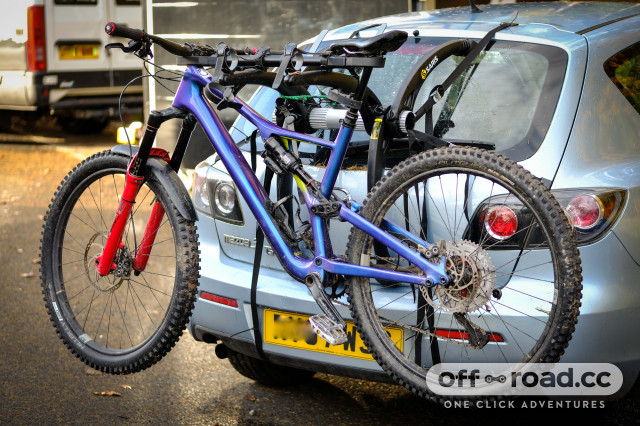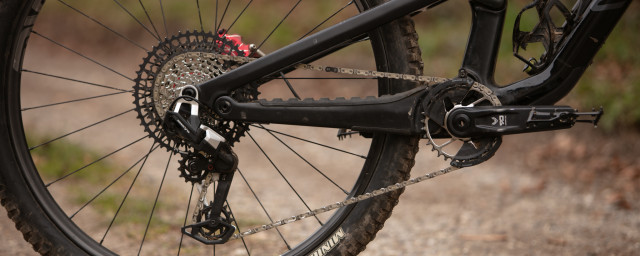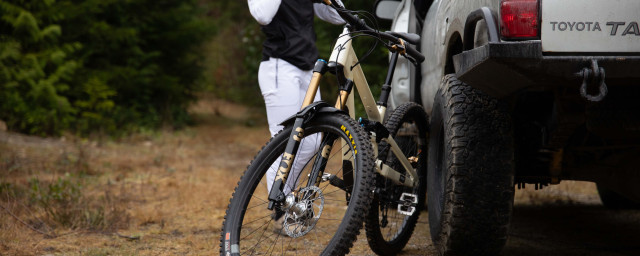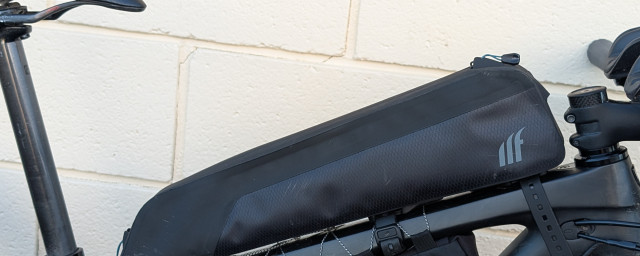Best way to transport mountain bikes

We all dream of chalet life in the Alps. Where you roll your mountain bike out of front door, right onto a trail. A fantasy for many, but a happy reality for very few. Most mountain bikers drive to the trailhead. That’s a fact. It is a simple reality of singletrack scarcity and urbanisation. We can’t all live near the topography and terrain that makes mountain biking possible.
- 5 best upgrades for your new mountain or gravel bike
- Gravel bike vs mountain bike: what are the differences?
- Types of mountain bikes: every MTB category explained
One of the great frustrations is getting your mountain biking to the trailhead without damaging it. Or the vehicle being used as transport. Mountain bike geometry means they are heavier, longer and have much larger tyres than road bikes. And that means that many legacy road bike transport methods, don’t work for mountain biking. Or at least, require some reconsideration.
At off-road.cc, we know both cars and mountain bikes. And how the relationship can often become strained when the latter needs to join the former on a journey.
Should your mountain bike go inside the vehicle?
This is the budget method of mountain bike transport. Depending on the size of your bike and car, it might involve some disassembly but has many advantages. If you have a van, which we'll cover further down in this article, your bike-transporting life is made really easy.
Unless you have a van or large SUV, your mountain bike isn’t going to fit inside a car without removing the front wheel. If you drive a compact hatchback, you’ll probably need to remove both wheels - and make sure you insert some disc brake spacers in your brake callipers.
The method for transporting a mountain bike inside any vehicle is to fold down the seats and place old bedding or unloved towels on the seatback trim, to prevent your pedals from ruining it. Wheels are always a chore to secure, but if you are clever with seatbelts, use them as securing straps.
What are the significant advantages of transporting your mountain bike inside the car? It’s a lot more efficient, for one. You aren’t increasing drag coefficient and creating higher fuel consumption by having bikes attached to the vehicle’s exterior.
There’s the security element, too, with bikes inside the vehicle. If you need to stop at the convenience store en route to a ride for energy drinks or nutrition, you need not worry about your bike getting nicked off the bike rack. Bikes ‘inside’ also prevents catastrophic damage if you are rear-ended by another vehicle.
But as with anything in mountain biking, for all the benefits, there are downsides, too. The biggest issue with transporting a mountain bike in-car is the space constraint. If you are riding a large or extra-large frame, it will be a very tight fit in any compact vehicle. Padding those contact points between the frame, wheels, fork legs, handlebar ends, pedals, and your car’s cabin trim takes time and requires foresight. If you do it poorly, you risk scuffing and ruining your car’s interior trim.
There’s a safety risk, too, with transporting a bike in-car. During emergency braking, the frame, or any loose components, risk becoming forward flung projectiles.
What about a mountain bike on the roof?
You own a compact hatchback which is too small to accommodate your long, low and slack 29er mountain bike inside. Or you don’t want the risk of a bike being flung forward with momentum during an emergency braking event on the highway.
One option is for rooftop mountain bike racks. This method of carrying bikes has a significant fuel consumption penalty, as it will generate a lot of drag. You also need to be mindful of obstacle clearance height on country lanes, regarding overhanding branches, which can do great damage if your roof-mountain bike impacts them while driving along.
Roof-mounted bike racks are more affordable than the towbar versions, with most vehicles having roof gutters or rails, designed to serve as a foundation for mounting hardware. But you need to be confident of lifting your mountain bike aloft and stabilising it to rachet those attachment straps and downtube arm into place - which is especially difficult if you're not very tall. And if you own a heavy mountain bike or have legacy shoulder and back issues, that’s a potential injury risk. For e-bike riders, a roof mountain option isn’t workable due to the hefting risk of an e-bike’s mass.
If you carry two average 15kg mountain bikes on the roof, be aware of how that could influence your vehicle’s centre of mass. It might not sound like much, but in automotive engineering, adding 40kg (bike and bike rack) to the roofline of a small vehicle with narrow tyres is considered a pretty notable influence on its centre of mass and lateral responsiveness.
Are mountain bikes best on the back?
If your bad back and sense of anxiety do not allow mountain bikes to be lofted onto the roof of a vehicle, your next option is to have them on the back.
The best rear-mounted bike rack is attached to a towbar, implying that your vehicle must have a towbar. You can go with the much cheaper clip-on option, but it has constraints regarding how many bikes it can carry, and the attachment mechanisms can damage your car.
If you are transporting mountain bikes with a rack attached to the rear of a vehicle, you want to get something sturdy and adjustable. Once the towbar bike rack is mounted, you’ll lose access to the boot or liftgate of your vehicle. And that can be hugely annoying.
The best towbar bike racks have a swivel and pitch mechanism, allowing you to tilt the rack away from a vehicle. This will enable you to retain access to the rear load space (where your gear is), via the boot or liftgate.
How does a towbar rack influence aero? There will be an increase in aerodynamic drag, but it’s less than having bikes on the roof. An issue to consider is that with three heavy e-bikes on a towbar rack, you might start feeling some longitudinal mass distribution issues on a small vehicle. This would be similar to the yawing/bopping sensation of a small vehicle towing a caravan hitched at the incorrect height.
Rear-mounted bikes are also directly in the path of an impact if an inattentive driver crashes into you, or you accidentally make an error of judgement while reversing with the bikes mounted.
And then there is the exhaust issue. If you drive a high-performance vehicle, with a powerful or large-capacity engine, its exhaust ends can run very hot. And often, those exhaust ends are directly in-line with your mounted bike’s wheels on a towbar rack.
It is not uncommon or impossible for expensive carbon wheels to get melted by the heated exhaust gasses of a high-performance vehicle, during a long drive at high speeds. When mounting your bike on a towbar rack, be attentive to where its wheels are in relation to the vehicle’s exhaust ends.
Pick-up trucks and tailgate pads
Popularised by American and Canadian mountain bikers, where pick-up trucks are a popular transport method, nothing makes more of a ‘core’ mountain bike statement, than the tail pad.
There are various tailgate pad products on the market, but they all work on a similar principle. The tailgate pad is a soft guard, which looks like something you’d use at the gym when doing floor exercises. It straps into place around the tailgate of your pick-up truck.
You don’t need to remove any wheels. Place the rear wheel in your pick-up truck’s load box, turn the handlebars through 90 degrees, and rest the fork leg against the tail pad.
The best tail pad designs have additional straps that loop around the downtube or even link into the fork legs, to keep bikes more surely in place.
What are the benefits of using a tail pad? For pick-up truck owners, this is the only sensible method. Not only does it look cool, but the packaging is amazing. You can easily fit four mountain bikes in the back of the pick-up truck’s load box using a tail pad. There’s minimal risk of damaging bikes because the only point of contact is against the generously padded tail pad surface.
Disadvantages of the tail pad? Very little. The securing method is sound. You aren’t ruining the vehicle's aerodynamics by too much. And it is reasonably easy to heft a mountain bike into the load box of a pick-up truck. And a tail pad is very comfortable for leaning against when having a post-ride chat in the trailhead’s parking area.
Tyre size and bike rack compatibility
Mountain bike tyre sizes have grown significantly over the last few years. Where most standard cross-country and trail bikes were rolling 2.25in width tyres a while back, the default size has become 2.4in. That might not calculate much difference for non-riders, but it is. And can become an issue with bike racks.
Most bike racks were designed to accommodate average-sized tyres, dating from the mid-2010s. Updating the moulds that make those bike rack tyre grooves has not been a product priority for bike rack brands. But it is changing, as the e-bike market has grown and all e-bike roll really big tyres.
If you are rolling 29x2.4in trail-wide tyres or any 2.5/2.6in tyres, you might discover some legacy bike racks have tyre grooves too narrow for your bike to rest on. Again, another example of the van (allowing for bikes to travel inside), or pick-up truck with a tail pad, being superior solutions for mountain bike transport. As opposed to bike racks.
Carrying your bike, or multiple bikes in a van
For many mountain bikers, or any cyclist for that matter, there's nothing quite like a van. Often, they're cavernous and have plenty of space to carry one, or a number of bikes. However, as they're often a blank canvas it can be tough to find a place to start safely travelling without your bikes rattling around.
First off, you can take advantage of the many anchor points on a van's bed and the walls to hook ratchet straps, or bungee cords. Using these, simple roll your bike into the back and strap is against a wall, using rags, sheets or anything soft you can find to make sure the straps, or the van's walls aren't in direct contact with your frame.
You can also purchase axle stands. These are small brackets that screw into your van's floor (if it's wooden) or into any cleverly placed bit of wood, or you can take advantage of the Saris Track system. The benefit of these is that they'll keep your bike upright using your bike's fork axle as support. They can also be arranged to accommodate multiple bikes in a small space which is ideal if you use your can for other things, whilst travelling with bikes. The downside is that you'll need to find a place to keep your front wheel(s).
There are also racks from BikeStow. These are wooden racks that can be secured in the back of a van that can hold up to four bikes, fully built. A BikeStow rack can accommodate almost all wheel sizes and tyres up to 3", and when not in use, it can fold flat.
Each of these options are sturdy enough to mount an e-bike weight bike with not issue.
You might also like:
- Cross-country mountain bikes: understanding their design and geometry
- Mountain bike tyre pressures – everything you need to know
- Best hardtail mountain bikes 2023 - great hardtails for every budget















